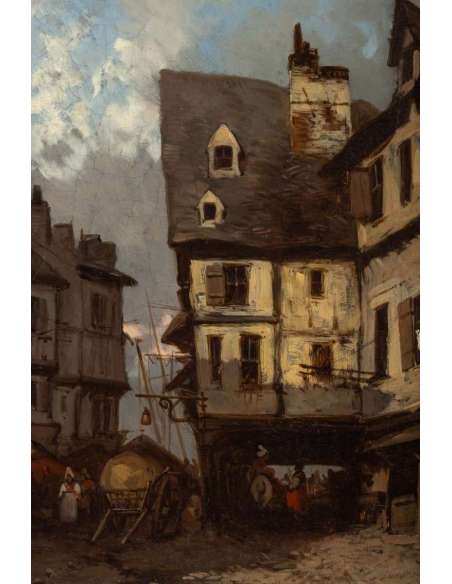"Johannes BOSBOOM (1817 – 1891)- View of Rouen- Circa 1837-1839."
Rouen- View of the lively old town- Circa 1837-1839.
Oil on monogrammed panel at the bottom left.
Dimensions: 26.5 x 20.5 cm, with frame: 42.5 x 36 cm.
Johannes Bosboom represents here a delicate view of Rouen.
It can be located between 1837 and 1839, during which time he went to France. He painted the Quai de Paris in Rouen in 1839, a painting kept at the Rijksmuseum in Amsterdam.
The degree of detail peculiar to the Flemish school is emphasized.
A lot of animation in the street, a hay cart in the foreground, a market with merchandise stalls. We can see in the background the masts of the boats moored on the banks of the Seine.
The key is free. His colorful palette is restricted: the painter focuses on drawing and above all, on light. A ray of sunlight illuminates the facade and obscures, by contrast, the lower part of the painting playing on a chiaroscuro.
Belgian painter and watercolorist. Coming from an Austrian noble family, his parents had to emigrate to Belgium before his birth for political reasons.
In 1831, Johannes Bosboom attended the workshop of Bartholomeus J. van Hove, urban landscape painter from The Hague. At first, Bosboom helped his teacher create theater sets and urban landscapes. Around the age of 20, he decided to focus on the representation of church interiors. This decision determined his entire career, his works in this genre having to establish his reputation.
Subsequently, he wrote, he was influenced by the Romantic movement, in particular by Wijnand Johannes Josephus Nuyen. Although Nuyen's influence is evident in his early works, he gradually abandoned Romanticism for a more sober treatment of his subjects.
After training in The Hague, Bosboom went to Germany, Belgium and France between 1835 and 1839 with his fellow students Samuel Verveer and Cornelis Kruseman. In 1851, he married the historical novelist Anna Louisa Geertruida Toussaint. Subsequently, he settled in the region and the village that saw him born, Alkmaar.
Bosboom exhibited a lot and received many honors during his life. It belongs to a long Dutch tradition of church interior painting established by Gerrit Houckgeest and Emanuel van Witte. He was seen, thanks to his freer watercolors and his vision of the fishing port of Scheveningen painted in the summer of 1873, as a painter of influence on the younger generation of the Hague school.
After the death of his twin brother Nicolas in 1862, Bosboom experienced a period of mild depression. In 1876, he stayed in the rural provinces of Groningen and Drente, where agricultural life and local churches informed him. During the last ten years of his active life, he worked almost entirely in watercolor.
Museum:
Paris, The Louvre, Amsterdam, Rijksmuseum, The Hague, Groningen,
Glasgow, Hanover, Munich, Montreal.
Bibliography :
. The memoirs of Johannes Bosboom.
. art."Johannes Bosboom (1817 – 1891)", Bénézit, Oxford Art Online
Description
Reviews
No reviews
Johannes BOSBOOM (1817 – 1891)- View of Rouen- Circa 1837-1839.
Vendu
3500 €








Period:
XIX th c.
Style:
Classical Art
Material:
Oil on canvas
Signatures:
Johannes BOSBOOM
Origin:
French school
- Widht :
- 20,5 cm (8 In)
- Height :
- 26,5 cm (10,34 In)
2023-02-03
728 people viewed this item

 English
English  Français
Français







